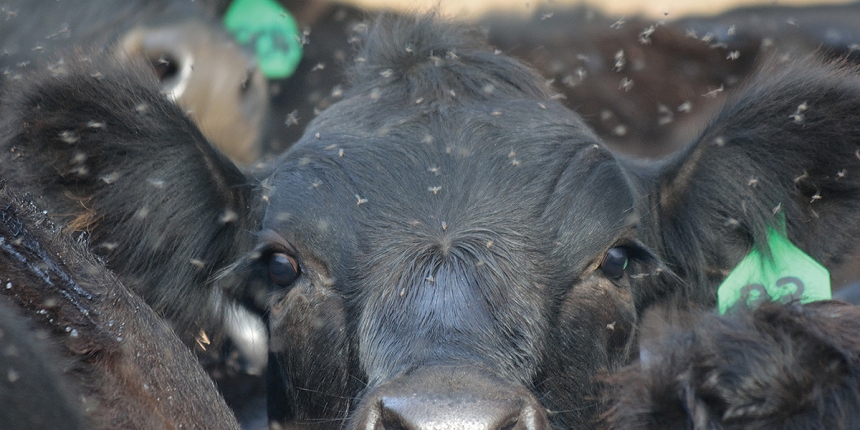
Agricultural News
Shoo Fly, Don't Bother Me. Or my Cows!
Wed, 07 Jul 2021 08:37:09 CDT
 Farming in the winter is usually not a livestock producer's favorite time of the year. But, if I must give it a positive aspect, the lack of flies and other flying pests make it somewhat enjoyable compared to when those same critters burst forth in full swing come summer.
Farming in the winter is usually not a livestock producer's favorite time of the year. But, if I must give it a positive aspect, the lack of flies and other flying pests make it somewhat enjoyable compared to when those same critters burst forth in full swing come summer.
Flies, mosquitoes, and biting gnats can cause a plethora of problems on the farm, including the spread of disease and causing undue stress to stock, leading to diminished performance. House flies are the benign, although annoying, fly species that you may encounter in confinement situations, such as freestall barns or covered feedlots compared to pastured animals. Sanitation is the main management strategy to keep them under control. Keep manure and old feed from remaining near animals too long. You may also choose to purchase a parasitic wasp kit for your region. These wasps feed upon the larvae of the flies, preventing the metamorphosis into adulthood. This strategy is to be done in conjunction with increased sanitation.
Biting flies are the major pests of cattle and can be split into two groups based on their mouthparts. Biting flies can have a piercing/sucking mouthpart or a scissor-like mouthpart. Stable flies fall into the piercing/sucking category and like to attack the legs of animals. According to Oklahoma State University, beef cattle in a feedlot setting with more than 5 flies per foreleg can decrease their average daily weight gain by 0.48 lb/day. The university states that this can increase an animal's time in the feedlot by up to 30 days a large increase in costs especially with current feed prices. Stable flies prefer to reproduce in moist environments, so soiled bedding, old feed, and manure piles are prime areas to locate stable fly eggs. Sanitation, sticky traps, and sprays can help in controlling this fly population.
Horn flies, on the other hand, are considered to be the greatest pest of cattle on pasture. Economic hits of about $700 million per year are felt by the U.S. beef industry from this fly (University of Florida). Male and female flies take blood meals and spend the entirety of their life on cattle. The action threshold for horn flies is 200 flies/animal and when flies are properly controlled, growing and finishing cattle are able to gain 1.5 more pounds per day. Insecticides and insecticide-impregnated ear tags are effective control methods when formulas are rotated to prevent insect resistance.
The flies that bite with scissor-like mouthparts are called tabanids and cause extreme pain and bleeding when present in great population numbers. Tabanids include the green-headed horse fly, the black horse fly, and the deer fly. Identification of these flies is relatively easy: the green-headed fly will be green in appearance; the black horse fly is probably the most recognizable with its large size and intimidating buzzing of wings; the deer fly will be smallest of the bunch and gray in appearance. These flies prefer to lay their eggs in muddy ground near ponds and streams, so control at reproduction can be difficult. Permethrin sprays can be effective for short bouts of time but wear away quickly. An oil-based spray will last longer for animals housed on pasture. These flies are important to control not only because of the discomfort they cause, but also because they have been documented to carry anaplasmosis, a blood disease that destroys red blood cells, and tularemia, a disease affecting lymph nodes and lungs.
The last fly to discuss is the heel fly, often called northern cattle grubs. Eggs are laid on the hair of cattle and the larvae burrow into the skin, eventually migrating to the crest of the neck and the spine. Once along the back of the animal, the larvae will again cut through the hide to breathe through a hole called a warble. This not only causes cattle to decrease performance and weight gain, but also reduces value of the hide for leather use and potentially the amount of carcass if warbling is extensive. Using pour-on or injectable endectocides are methods of control but may cause inflammation or other adverse effects if applied once larvae reach the esophageal and spinal area (Ohio treatment cutoff date is November 1). Talk with your veterinarian to determine the best course of action.
Flies can be largely detrimental to a cattle operation whether it is dairy or beef or in confinement or on pasture. So, in summary, be vigilant in your pest control to control profit loss and improve cattle welfare. Your cattle will thank you!
Article courtesy of Haley Zynda, AgNR Educator, OSU Extension Wayne County for u.osu.edu
WebReadyTM Powered by WireReady® NSI
Top Agricultural News
More Headlines...





